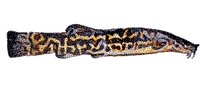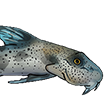hi milton.
The growth rate of L333 compares favorably well to that of Peckoltia L134. They have been a rapid growing species compared to other Hypancistrus spp which belong to the smaller sized species like l260 and H. zebra so I was not being very accurate by lumping the Hypancistrus spp together. L333 and L66 are among the larger members of the group, tend to be more prolific and their young grow twice as fast as L260 for the sake of comparison. I have L333 which are 8 to 10 months old ranging from 1-1/2 to just over 1-3/4 inches TL and show now signs of slowed growth yet. I do think they will take about 3 years to reach sexual maturity which is longer than that of Peckoltia sp L134. Until I actually have bred F1 l333 I can't speak from personal experience. All my breeders are wild fish and of unknown ages. I have had them just over 2 years and they have not grown during that time. I did not get around to setting the L333 in a breeding tank until a little more than a year after I received them but they spawned within six weeks once in their breeding tank. we do know that L333 and L66 are two of the easiest Hypancistrus to breed and among the most prolific. A typical brood of L333 runs between 40 and 60 fry from my fish. But remember, I have some very mature breeders. I have read of even larger spawns coming from the larger species, L66.
I still have questions about how old and for how long L134 can live and breed. I know that some owners of breeding wild H. zebra who have had spawns from fish which must be at least 13 years old.
There is often a relationship between the time fish mature and their ultimate life span but as I am sure you are aware, there is very little recorded information about the actual life cycles of most pleco species.
My own wild L134 breeders have to be at least 6 years old. They arrived at 2-3/4 to 3 inches so I would guess those were between 2 and 3 years old. They did not begin spawning for me until after I had had them for a little more than 2 years. That was almost 3 years ago. We still have much to learn about the biology of many of the most popular pleco species, at least as it proceeds in captivity. We probably know much less about their biology in the wild.
My average size L134 spawn is 25 to 30 fry but my largest brood numbered about 40 fry but that is not typical of my group. I am changing water and while working on a one of the 40 gal breeders which has a possible pair of wild lenquer Discus and many of my oldest F1 L134 I caught a glimpse of what appeared to be a L134 fry about 2 weeks old. It was only a glimpse so what I saw may have been one of the Corydoras habrosus that are in the same tank but it didn't , look right. Before I refill their tank I will see if I can discover whether or not their really is at least one juvenile L134. I do not have any caves which they could have used for a spawning site but when fish choose to breed they often improvise. I hope I do find a even a single F2 L134 fry. That would be sufficient evidence that they are ready to be set up in a proper spawning tank furnished with wood and caves. Learning the answers to these questions are part of what makes keeping and breeding fish such a fascinating hobby.
If I do find an F2 L134 in this tank I will begin to set up two separate breeding tanks since I have about 3 dozen F1 L134 about 2 years old. If I can begin breeding two large colonies it will allow me to sell in large wholesale quantities to a couple of preferred on-line breeders. Up tp now, I only produce enough for more limited retail sales.
I like and enjoy raising plecos because they are not demanding species but my main project is to breed Red Alenquer and Royal Blue S. haraldi and also Green Discus, S. aequifasiata. I have previous experience breeding wild S. haraldi but this will be my first serious attempts to breed wild green Discus. Green Discus are more demanding of specific water chemistry than the Brown/Blue S. haraldi so success is likely to only come with increased diligence. There is a movement within the Discus hobby to go back to the wild fish. Only a small percentage of all Discus aficionados are drwn to the wild types but anyone who can supply F1 Dcus from wild parents will not have any trouble selling them. It is not the path of least resistance, to be sure, but any competent fish keeper can breed and raise domestic Discus so the between the commercial sources and hobbyists it is a crowded field. Not so when it comes to wild or F1 wild specimens.
My involvement with Discus goese back over 4 decades and I began breeding wild Discus long before the advent of the plethora of domestic strains existed. I bred 1000's of domestics and plenty of my old customers continue to ask me if I have some for sale but I sold all my domestic Discus to concentrate on wild fish again. My involvement with the small fancy plecos only began in early 2006. They have proved to catch my interest so I will continue my pleco breeding as i work on my wild Discus breeding program. I have 16 F1 Blue Discus coming in this week and I am in the process of cleaning my tanks before they arrrive and am still trying to induce a spawn from one of my wild red Alenquer Discus pairs. I have a friend in town with whom I have collaborated many years on various fish breeding projects. He is short on tank space but is trying to get his Stendker brilliant Turquoise Discus to raise some spawns. The first pair spawned within 10 after their arrival but we received some badly stunted fish. They raised that first spawn but have eaten every brood since. Some of the progeny are now old enough to breed so if he can resume raising them I will take them after they have become independent from their parents so then I will raise them to a salable size. If this works I will be able to offer a domestic strain in addition to F1 wild juveniles. The best of both worlds. It had been so long since he last bred domestic discus that he forgot how much food, especially live Artemia nauplii young discus require so he stunted his first and only successful spawn. But still, enough fish were salvaged that we should be able to establish a domestic Brilliant Turquoise breeding program. Discus photos;



Avid Trout fly fisherman. ·´¯`·...¸><)))º>









